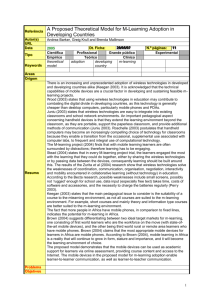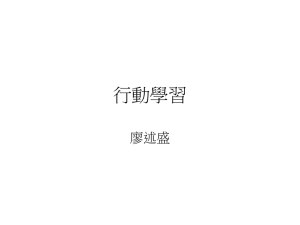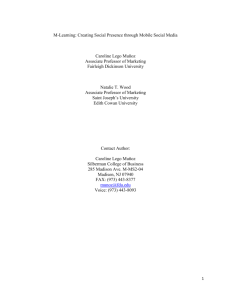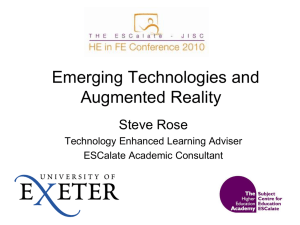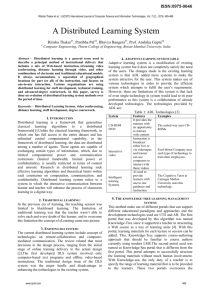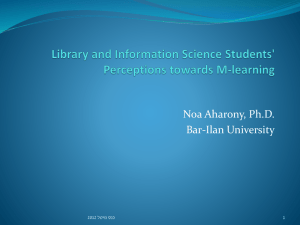M-Learning: How can I use m-Learning in the classroom? Summary:
advertisement
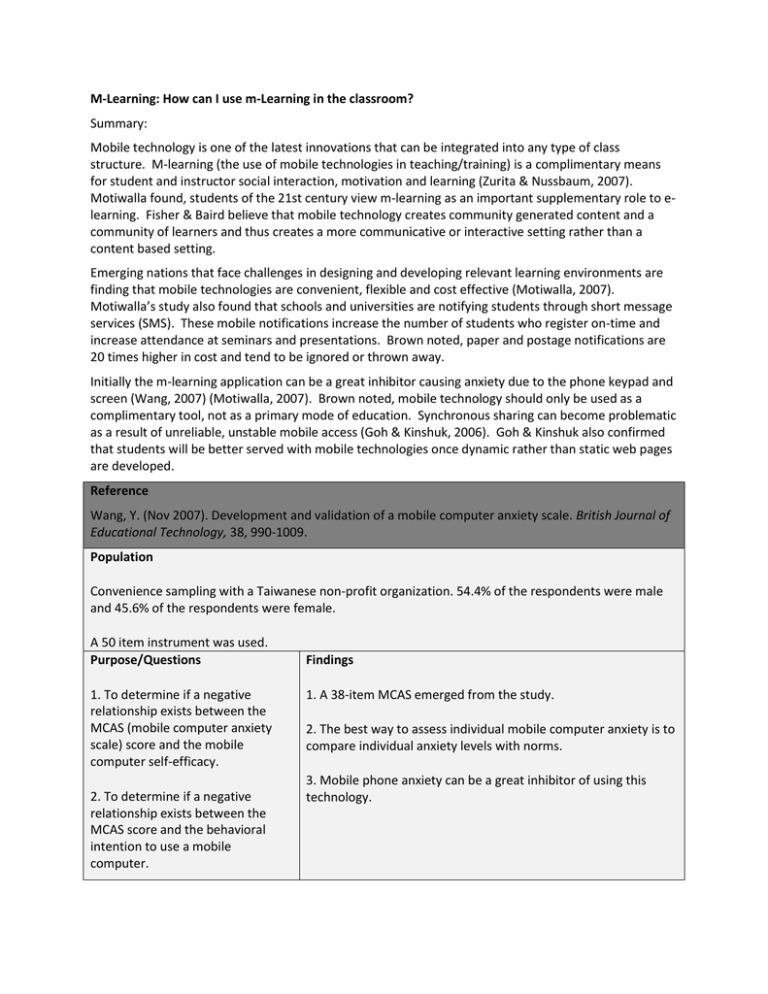
M-Learning: How can I use m-Learning in the classroom? Summary: Mobile technology is one of the latest innovations that can be integrated into any type of class structure. M-learning (the use of mobile technologies in teaching/training) is a complimentary means for student and instructor social interaction, motivation and learning (Zurita & Nussbaum, 2007). Motiwalla found, students of the 21st century view m-learning as an important supplementary role to elearning. Fisher & Baird believe that mobile technology creates community generated content and a community of learners and thus creates a more communicative or interactive setting rather than a content based setting. Emerging nations that face challenges in designing and developing relevant learning environments are finding that mobile technologies are convenient, flexible and cost effective (Motiwalla, 2007). Motiwalla’s study also found that schools and universities are notifying students through short message services (SMS). These mobile notifications increase the number of students who register on-time and increase attendance at seminars and presentations. Brown noted, paper and postage notifications are 20 times higher in cost and tend to be ignored or thrown away. Initially the m-learning application can be a great inhibitor causing anxiety due to the phone keypad and screen (Wang, 2007) (Motiwalla, 2007). Brown noted, mobile technology should only be used as a complimentary tool, not as a primary mode of education. Synchronous sharing can become problematic as a result of unreliable, unstable mobile access (Goh & Kinshuk, 2006). Goh & Kinshuk also confirmed that students will be better served with mobile technologies once dynamic rather than static web pages are developed. Reference Wang, Y. (Nov 2007). Development and validation of a mobile computer anxiety scale. British Journal of Educational Technology, 38, 990-1009. Population Convenience sampling with a Taiwanese non-profit organization. 54.4% of the respondents were male and 45.6% of the respondents were female. A 50 item instrument was used. Purpose/Questions 1. To determine if a negative relationship exists between the MCAS (mobile computer anxiety scale) score and the mobile computer self-efficacy. 2. To determine if a negative relationship exists between the MCAS score and the behavioral intention to use a mobile computer. Findings 1. A 38-item MCAS emerged from the study. 2. The best way to assess individual mobile computer anxiety is to compare individual anxiety levels with norms. 3. Mobile phone anxiety can be a great inhibitor of using this technology. Reference Motiwalla, L. F. (2007). Mobile Learning: A framework and evaluation. Computers & Education, 4, 581596. Population To investigate the usage of mobile learning in distance learning in higher education. There were sixty three participants in the study. They were undergraduate and graduate students at Massachusetts Lowell College of Management. Purpose/Questions Findings A prototype application was developed to link wireless/handheld (W/H) devices to three course websites. The application framework consists of two levels or two phases of research and analysis: mobile connectivity and e-learning. Two phases were followed by two attitudinal surveys: in phase one the emphasis was only on student satisfaction with our application, while in phase two the emphasis was on student satisfaction and their general perceptions on the role of m-learning in higher education. The participants needed to access the courses from both regular PC/notebook internet and m-learning. First phase: The students found the m-learning useful and a good complimentary tool for the classroom interaction. They rated neutral on ease-of-use, but found the interaction tools easy for discussing course materials with other students and instructors. They found the mobile phone keypad and screens very difficult while navigating, reading and typing their messages. However, once they overcame this user-interface hurdle the m-learning applications used for classroom interaction were easier to understand. The m-learning applications were pilot-tested for two semesters. The students used the m-learning environment with a variety of wireless/handheld (W/H) devices and reported their experiences through a survey and interviews at the end of the semester for two semesters. The attitudinal surveys used a 5-point Likert scale with strongly agree as 5, neutral as 3 and strongly disagree as 1 on the Likert scale Second phase: The students foresee m-learning as an effective learning tool or aid, providing flexible access from anywhere and convenient to use application. Students also perceive and important supplementary role for wireless/handheld devices in elearning and are effective in delivering personalized content. Reference Brown, T. H. (2005).Towards a model for m-learning in Africa. International Journal on E-Learning. 4, 299-316. Population The population for the study was as follows: 100% full -time employees (teaching), 77.4% English second language speakers, 22.6% English first language speakers, 83.8% between the age of 31-50, 13.9% younger than 31, 66.4% were women, 97.3% non-white, 0.4% access to email, and 99.4% had a mobile phone. Purpose/Questions Findings Tom H. Brown from the University of Pretoria, South Africa was interested in finding out more information about M-Learning in Africa. The main question that the research posed was why there is a move towards M-Learning in Africa? This question has been asked mainly because the people in Africa do not certainly fit the characteristics of the developing nations which fit the ideal population for M-Learning. During the months of November 2002 to February 2003, SMS messages sent to students and administrative staff. The some SMS messages were send to staff to provide basic administrative information and other SMS messages were sent to the learners as reminders of important dates for activities like contact classes, examination registration, examinations, notification of study material distribution. The results from the research proved that M-Learning had a lot of advantages for the learners in Africa. There was an increase in the number students registering early for classes because they were getting their reminders on time via SMS. 95% of the students previously registered for contact sessions were attending the sessions because they were getting reminders through SMS messages. The cost of distributing necessary information using print and postal services to the learners was 20 times higher than using the SMS. Another great advantage of using SMS was that it provided JIT (just-in-time) information as compared to the time it took to post the information. There is a challenge to design and develop relevant learning environments, based on sound pedagogical principles that will ensure the optimization of learning in the m-learning environment. E-Learning encompasses M-Learning and studies show that MLearning serves more of a communication approach than a content approach. Therefore the major focus of M-Learning should be more on communication and interaction than on content. M-Learning supports other forms of education and cannot be treated as a primary mode of education. The most appropriate mobile device for learners in Africa is a mobile phone and possibilities and latest developments in mobile technologies must be tested against practicality, usability, and cost-effectiveness. Reference Goh, A. T., & Kinshuk, D. (2006). Getting ready for mobile learning—Adaptation perspective. Journal of Educational Multimedia & Hypermedia, 15, 175-198. Population n/a Purpose/Questions The authors of this article are concerned with the significance of the m-learning environment upon existing learning environments (such as distance learning, pedagogical/learning theory, and games/competition in learning), their implications, and the importance of tailoring web based information to mobile device formats. Reference Findings The findings support the need for synchronous sharing within mobile access is necessitated due to the unreliable nature of current mobile access as opposed to fixed line access, and further research in the area of prefetching to reduce time needed for page loads, is suggested. The authors also advocate for developers to move towards dynamic rather than static pages. Walton, G., Childst, S., & Blenkinsopp, E. Using mobile technologies to give health students access to learning resources in the UK community setting. Health Information and Libraries Journal, 22, Retrieved 24 September, from http://web.ebscohost.com/ehost/pdf?vid=22&hid=109&sid=4a757517-86e4-4124aa9d-484ffba02c76%40sessionmgr104. Population 49 health students at the Northumbria University, UK Purpose/Questions Findings Identify possible barriers students could face in using mobile technologies. With the students surveyed: Assess the students’ perceptions of the importance of being able to access learning resources. Mobile technologies were mainly being used for clinical applications rather than learning applications. Students showed a low level of awareness of the technology but placed a high value on the ability to access learning resources. Implications: Librarians play an important role in training students as use of new electronic resources increases. Health professionals and students value e-journals and electronic databases because of their lack of immediate access to a physical library. Reference Zurita, G., & Nussbaum, M. (2007). A conceptual framework based on activity theory for mobile CSCL. British Journal of Educational Technology, 38, 211-23. Population 24 participants from low income public primary school in Santiago de Chile consisting of 6 and 7 year with basic math skills were selected. A survey of student opinions regarding college teaching and learning was given in two section of the course with 235 students (137 first year, 98 second year) completed the survey. Purpose/Questions Findings This article provides a conceptual framework for teaching basic mathematical skills on handheld computers interconnect by a wireless network. The purpose of this article is to open opportunities for changing pedagogical practices while taking the support of computer technology. The result of the study shows that the students had minor technological problems but by the end of the pilot study they were experts. The students realized that mutual support was fundamental in achieving their goal. The study shows positive effects on the student social interaction, motivation and learning. Reference Fisher, M, & Baird, D. (2007). Making m-learning work: Utilizing Mobile Technology for active exploration, collaboration, assessment, and reflection in higher education. Journal of Educational Technology systems, 35, 3-30. Population A survey of student opinions regarding college teaching and learning was given in two section of the course with 235 students (137 first year, 98 second year) completed the survey. Purpose/Questions Findings The purpose of this study is to provide specific strategies that faculty could use to make mlearning environments more engaging and for enhance studentcentered learning to meet the digital learning styles of the student population. Student Learning Preferences 67% preferred group work, interaction, and having discussion with peers and instructor. 17% preferred short lectures, embedded with professional experiences 8% preferred traditional teacher led lecture. Learning and Technology Method: Students had access to the Virtual Graffiti tool through a mobile phone number or the Web. 100% of the student population had access to a mobile-enabled device. The phone features helped learners with limited typing skills. It also allowed quick and easy 91% of instructors and students use latest technologies 98% believe they play a most responsible role in their learning. Overall findings from Survey Best lectures : 1/3 rd students said that characteristics like passion, motivation, charisma, approachable, connectivity and lowered the duration of interactions. Questionnaire: The National College of Ireland provided a short questionnaire to all the students in Business Communications course. The feedback through the survey was collected at the beginning of the semester. The survey was anonymous and voluntary. Interview: several participants were interviewed after their experience with the mural building with mobile class activity (i.e. mlearning class). creative, interesting, interactive were cited more frequently than other characteristics, as intelligent, knowledgeable, professionally experienced, strict, clarity, organized, and ability to control class. Good Communication skills were highly valued. Over half of the students wanted feedback on how things can be made easier, written feedback, constructive criticism, direct answers, and continuous assessment. 1st and 2nd year students both expressed similar opinions. But the second year students wanted more critical thinking learning activities other than group discussion to practice problem solving decision making and teamwork skills. While first year students prefer homework. Findings from Interview/Class Students expressed flexibility of the content and format in the event, and the fact that it was teacher-led. High attendance and completion rates resulted from this approach. Motivation and support were central to the whole process. Good quality posts were produced, which were important outcome of the project as well as demonstrating participant-learners’ technical awareness. Return posts to the Website after classroom event was another demonstration of its effectiveness, indicating they had a positive experience. Key Findings of the National College of Ireland m-learning project: High attendance , high levels of participation and completion from learners. Realization and publication of student-initiated, learner produced content to the classroom mural and Web. Creation of an expanding model suited to the Irish curriculum, tried and tested in the classroom. Awareness -raising of the potential uses of mobile technologies in education, and encouragement of curricular use of the resources produced in class. The creation of a community of learners. Creation of user and community generated content.

